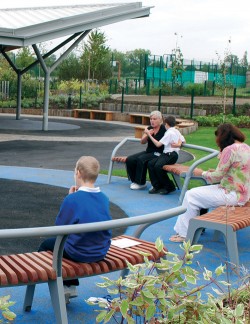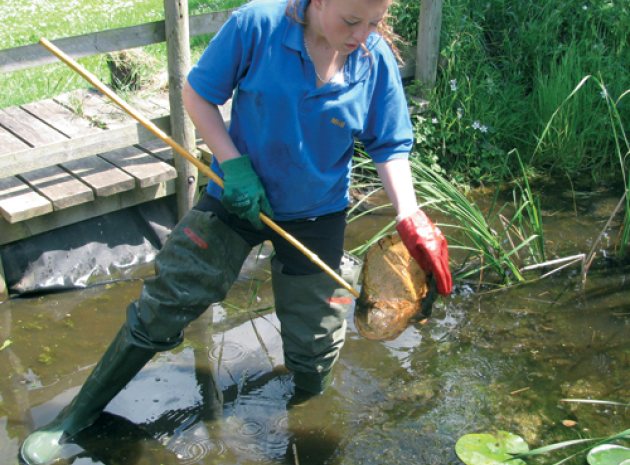When a new secondary school is built or an existing one refurbished it is often easy to see where the priorities lie – impressive, statement buildings; up-to-the-minute technology; and fancy new furniture that would look at home in any trendy London pad. And while all these elements can have a beneficial impact on, for example, learning and the self-esteem of pupils, what about the school grounds? When budgets get tight, the outdoor environment is often the first space to get ‘value engineered’ out of the proposals (with the possible exception of first-class sports facilities). Yet getting these spaces right can prove to be a costeffective, high-impact addition to any school site.
Architects may argue that buildings need to be right from the start while landscapes can develop over time. But not planning the school site as a whole can lead to underused, undervalued and un-cared-for spaces that add little to the experience of the young people they serve. When secondary schools do use their grounds, teaching and learning are greatly enhanced, pupils are motivated and teachers are also re-enthused. Where the environment has been designed to support learning, play and socialising, pupils and teachers are able to make the most of it straight away. Where little has been done outside then teachers not only have to think about what they can teach outside but also about creating the resources to enable this to happen.
Moreover, in this sector the importance of socialising features highly. Students need spaces to gather and to meet with friends, designed in a way that promotes interaction – so long rows of benches, for example, are generally not going to be the most effective. In contrast, horse-shoe shaped seating means that spaces designed around social interaction can also function well as spaces for learning, thus adding value to the features.
In 2009 a MORI poll showed that 97% of teachers believe that schools need to use their outside spaces effectively to enhance their pupils’ development, but 80% claim that their school is failing to maximise the potential of this valuable resource. It is obvious, therefore, that there is a gap between what teachers believe should happen and what is occurring on the ground. So how do you ensure this doesn’t continue?

Getting it Right
The first and most important factor is the enthusiasm and determination of teaching staff to get good grounds. They need to make designers understand that this is a priority for their school. Even if the budget gets cut, the framework of the outside space needs to be right so that this can be built on. Teachers also need to be able to express their ideas and needs to the designers – telling them how they teach outside and the way they want the grounds to be used. Designers don’t always understand this and, even with the best of intentions, they can get it wrong. One school I have visited asked for a wildlife pond – which they were duly given by the landscape architect. However, there was no dipping platform, no outside storage and not even a path leading up to the pond, making it virtually unusable without further development.
Schools also need to have some understanding of designers. One school was recently presented drawings of their site that included wonderful-looking grounds. However, these were only ‘impressions’ of what the grounds could look like and were never intended to be part of the build. Staff did not understand this and were therefore disappointed with what they ended up with. At another school, a ‘Key Stage 3 play area’ on a plan turned out to be a concrete bench with an area of tarmac in front of it. The key here is to not to be afraid to challenge the designers – you need to be sure they understand you, and you understand them.
Below are seven key pointers for making sure your designers give you the grounds you deserve. Challenge them on these and you are more likely to get great grounds:
1. The space should be designed for the users – this may sound obvious but sometimes the design can look good on paper but the designer has not given real consideration as to how the school will want to use the site.
2. The best school grounds allow for flexibility of use. Don’t let spaces get over-designed so that features can only be used in one way. Think about how different people might want to use the site and how this might change in the future.
3. Most designers understand that they need to consider sustainability in design, and this is particularly relevant to the outside space. The use of sustainably sourced materials, the way the grounds are planned and managed to increase biodiversity, or using local suppliers and contractors should all be considered.
4. Look at the diversity of spaces you want in your site. The wider the range of types, sizes and quality of space the more you will be able to use them in different ways.
5. How does the site work as a whole? Do the indoors and outdoors work together? How easy is access from inside to out? Can everyone move around the site with ease or are there some areas that should in fact be more of a challenge to reach?
6. Whilst many elements outside are less costly to create than indoor facilities this should not equate to low quality. It is important that, if spaces outside are to be seen as important and are to be long lasting, they are made by skilled craftspeople and builders, and that the materials used are the best possible.
7. Last, but certainly not least, engaging the whole school community in the design and development process will ensure you end up with grounds that fit the needs of the whole school and that whatever is developed will be appreciated and cared-for by the users. In secondary schools this can be a real learning experience for pupils and may even have an influence on their career choices, so it is an opportunity not to be missed.
However, even the best-designed grounds are not a success if they are not then used effectively. From cooking in solar ovens and creating wind-powered toy cars to performing Shakespeare and growing fruit and vegetables, secondary school grounds have the potential to engage pupils, to stimulate creative thinking, to enhance and complement the learning that takes place inside and to engender a love of the natural world. Your designers can help you make these spaces great but it will always be up to you to make the most of what you have been given.
Case studies
At Pioneer School in Basildon, Essex (image, far right), the site was designed to work as a whole. Classrooms have direct access to the outdoors, providing a wider range of experiences for the students; and the outdoor spaces relate to those inside, so that al fresco performance areas, for example, are adjacent to interior music and drama spaces.
In contrast, the rsa academy in tipton, west midlands has an impressive, new, high-tech indoor environment but the grounds were not incorporated into the design process. Teachers had to start from scratch to make the grounds work for them, but now pupils take part in a grow-your-own project, harvesting their crops for use by the school canteen, and they have great plans for the future, including building a cob oven to cook their own vegetables.
Mary Jackson is development and delivery officer for Learning Through Landscapes, a charity with the vision that every child benefits from outdoor learning and play throughout their education.
Info bar
Learning through landscapes can support your school in a variety of ways, for example:
‘Workout’ is a toolkit to help secondary schools develop their grounds. this is currently on offer for the reduced price of £30
‘Outside your comfort zone?’ is ltl’s national conference for 2012 and will be held at the rsa academy in tipton find out more at ltl.orgl.ik










